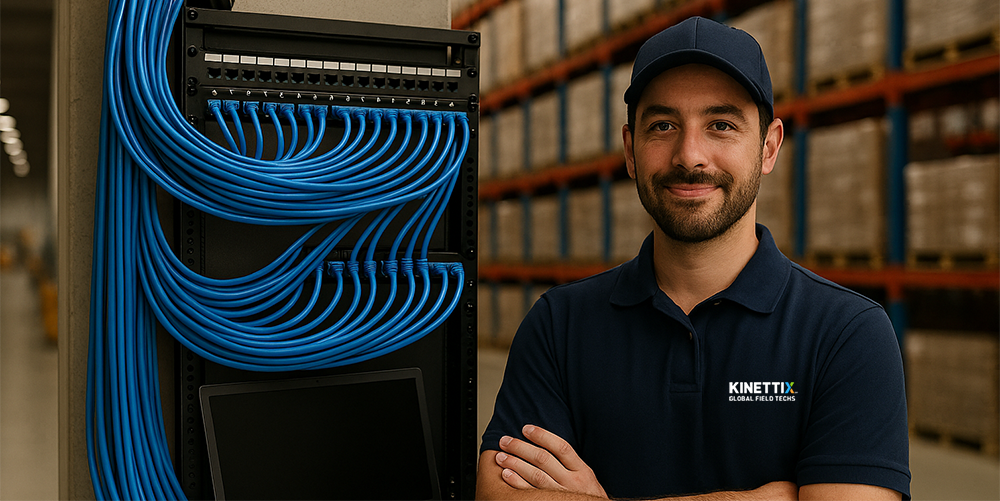Reliable network cable installation isn’t just about connecting devices—it’s a foundation for business growth, productivity, and security.
When scaling across 100+ sites, complexity multiplies rapidly:
- inconsistent standards
- poorly documented projects
- vendor confusion can threaten success and business productivity
However, when done right, network cabling forms a reliable foundation for an infrastructure that supports your current and future business needs.
The How and Why of Network Cabling: 4 Key Benefits

A network cable installation provides the physical backbone that enables data to flow between workstations, servers, wireless access points, and other network devices. The quality, type, and layout of cabling directly affect network speed, reliability, and scalability.
Key benefits of proper installation include:
- Optimizing bandwidth and minimizing latency
- Reducing interference and signal loss
- Ensuring compliance with industry standards
- Facilitating future upgrades and troubleshooting
Network cabling installation involves planning the physical paths for cables, selecting suitable cable types, terminating and testing each connection, and creating detailed documentation.
Each aspect—from selecting Cat6 over Cat5e ethernet cable, to implementing fiber backbone—must suit the operational requirements of your sites and support long-term business objectives.
Understanding the Main 5 Types of Network Cable for Industrial Deployments
Selecting the correct cable type is essential to getting the quality result your business requires.
Let’s look at a breakdown of the types of cable used for network installation optimized for enterprise-scale deployments:
|
Cable Type |
Best Use Cases |
Max Speed/Distance |
Key Advantages |
Enterprise Considerations |
|
Coaxial |
Legacy CCTV, building retrofits |
10 Mbps / 500m |
Durable, EMI-resistant |
Obsolete for modern data, limited use |
|
Cat5e |
Legacy retrofits only |
1 Gbps / 100m |
Low cost |
Obsolete for new installations |
|
Cat6 |
Standard business networks, retail locations |
10 Gbps / 55m, 5 Gbps / 100m |
Current standard, cost-effective |
Recommended minimum for new builds |
|
Cat6A |
Data centers, high-performance needs |
10 Gbps / 100m |
Future-proof, reliable |
Premium choice for critical infrastructure |
|
Fiber Optic |
Long distances, backbone connections, campus networks |
100+ Gbps / 10+ km |
Highest performance, EMI immune |
Ideal for site-to-site connections |
Additional considerations:
Innovations in data center management are rapidly transforming how businesses approach their IT infrastructure. Here are five emerging trends that promise to reshape operations for the better:
- Shielded vs. Unshielded: Use shielded twisted pair (STP) cabling for manufacturing floors or environments with substantial electromagnetic interference (EMI). Unshielded options (UTP) suit standard office or retail deployments.
- Plenum vs. Riser ratings: Plenum-rated cables are mandatory for installation in air-handling spaces due to fire regulations; riser-rated for vertical runs between floors.
- Standardization across portfolio: Adopting consistent cable specifications simplifies maintenance, enables streamlined upgrades, and ensures compliance across all locations.
6 Critical Mistakes That Derail Multi-Site Network Cable Installation Projects (& How to Avoid Them)
Even seasoned teams can stumble on large-scale ethernet cable installations.
Here are six critical errors we often see in the field. Kinettix recommends the following best practices to ensure every location, no matter the scale, benefits from world-class network cable installation:
- Treating Each Site Independently: Fragmented project management increases risk and oversight burdens. Standardize procedures and documentation from the start.
- Underestimating Vendor Coordination Complexity: Multiple local vendors in different geographies can lead to inconsistent results and delays. Centralize project oversight and enforce SLAs.
- Skipping Site Surveys: Avoiding thorough surveys to save time or money typically results in unexpected hurdles, coverage gaps, or regulatory breaches. Always conduct detailed site assessments.
- Inadequate Testing & Documentation: Rush jobs often overlook testing and record-keeping—leading to outages and costly troubleshooting. Implement multi-stage testing and detailed as-built documentation.
- Neglecting Cable Management: Poor labeling and tangled cables undermine efficiency and make future maintenance a nightmare. Invest in systematic labeling and neat management throughout.
- Failure to Comply With Local Codes: Building codes and compliance frameworks vary by region. Ensure vendors understand and adhere to all applicable regulations.
11 Best-Practice Steps for Superior Network Cabling

When you are implementing a rollout to a larger number of locations, consistency is the key. Standardization of practices, procedures, and labelling often avoids catastrophe and ensures a satisfactory result.
- Develop a Comprehensive Plan: Map out every site, including cable runs, access points, and physical constraints.
- Choose Quality Materials & Correct Cable Types: Avoid cost-cutting—invest in cables rated for speed, longevity, and safety.
- Maintain Proper Cable Bend Radius: Prevent signal loss and cable damage by adhering to manufacturer guidelines.
- Separate Network Cables From Electrical Wiring: Minimize EMI and ensure safety by using dedicated conduits and pathways.
- Systematic Labeling: Clear, standardized labels at both cable ends speed up troubleshooting and upgrades.
- Measure Accurately, Allow Service Loops: Prevent tension and facilitate future maintenance with strategic slack.
- Test at Multiple Stages: Validate every cable segment—before and after termination, and upon full installation.
- Organize Cables Neatly: Use cable trays, ties, and racks to maintain order and simplify moves/adds/changes.
- Select Appropriate Central Location: Position networking equipment for easy access and optimal signal distribution.
- Document Everything: Store plans, test reports, and specifications in a centralized repository accessible by all project stakeholders.
- Engage With Local Compliance Experts: Tap local knowledge for code adherence and permits—a Kinettix specialty.
Comparing DIY vs. Pro Cable Installation: Is It Better to Build Internally or to Buy from a Partner?
Many enterprises debate whether to deploy network cable installation using internal teams or outsource to a partner like Kinettix. Here’s a direct comparison:
|
Factor |
Internal Team |
Outsourced Partner |
|
Fixed Costs |
High (salaries, benefits, equipment, training) |
Low (pay per project) |
|
Variable Costs |
Low (already on payroll) |
Higher per-project rates |
|
Geographic Flexibility |
Limited to team locations |
Global coverage |
|
Scalability |
Difficult and slow |
Rapid scaling |
|
Quality Consistency |
Depends on team expertise |
Guaranteed through SLAs |
|
Best For |
High-volume, consistent need in one region |
Multi-site, project-based, or global operations |
3 Critical Questions to Consider:
- Is your team equipped for high-velocity rollouts in unfamiliar regions?
- Are you prepared to handle regulatory compliance and local code variations?
- Can you scale up or down on demand without excessive fixed costs?
For most enterprises with multi-site needs, a trusted field services partner delivers reliability, cost control, and peace of mind.
Answering Your Top 8 Questions About Enterprise Network Cabling

- How long does a typical multi-site network cable installation project take?
The timing of any project is dictated by the scope of the work.. A 1,000-site retail deployment might span months, even with concurrent teams working on the project. For every project, the timeline and needs of our customers are taken into account, and a suitable plan for accomplishing the project within the time parameters is developed. - What certifications should I look for in a network cabling provider?
Seek providers certified by BICSI, ETA, or CCCA, with portfolio experience in enterprise-scale and multi-site environments. All of our technicians meet these and many other rigorous standards. - Do we have the volume to justify full-time specialized staff?
If cabling is a core competency, internal teams make sense in one region. Otherwise, partners deliver turnkey expertise for variable or international needs. - Can we afford the travel costs for internal teams to reach all sites?
For national or global deployments, outsourced partners with distributed field teams eliminate travel overhead. - Do we need expertise in multiple building codes/compliance frameworks?
Absolutely. Each city, state, or country may impose unique regulations. We ensure every site is fully compliant. - How quickly do we need to scale up/down?
Rapid scaling is virtually impossible with internal resources. Kinettix’s global network deploys on demand, without delay. - How does Kinettix guarantee project consistency across global regions?
Through standardized processes, familiarity with the regulations and requirements of diverse locations, and consistent remote project management. - What support do you provide during planning?
End-to-end strategic guidance from initial surveys to final handoff, with transparent reporting at every step.
When Proper Installation Pays Off: How Kinettix Deployed Network Infrastructure Locations Seamlessly for a Large Manufacturer
Client Needs
A large manufacturer faced a critical need for up-to-date cabling and reliable network infrastructure in its Las Vegas, NV, facility. Their current hardware was aging, resulting in connectivity issues and risk of downtime.
With operations depending on seamless communication and secure data flow, the client required expert IT field technicians to upgrade, install, and test a facility-wide cabling and network solution—quickly and with minimal disruption.
Core Challenges:
- Replace obsolete cabling and network devices
- Minimize operational interruptions
- Adhere to strict project timelines
- Ensure scalable solutions for future growth
Kinettix’s Solution
We responded with a precisely engineered plan to meet the client’s needs. Our team conducted a thorough site survey, analyzed the client’s requirements, and crafted a custom scope of work for cabling and network installation.
Solution Highlights:
- Tailored project documentation and milestones
- Direct client engagement for expectations and feedback
- Proactive troubleshooting and contingency planning
- Real-time progress updates to the client’s leadership
Project Execution
Kinettix deployed certified technicians to the Las Vegas site, following stringent protocols for safety, accuracy, and efficiency. Every cable run and network hardware installation was mapped to the client’s unique operational footprint. Testing and validation routines ensured compliance, reliability, and optimal performance.
Execution Steps:
- Removal of legacy wiring and hardware
- Structured cabling installation supporting high-speed connectivity
- Deployment of network switches and secure endpoints
- Rigorous post-installation testing, documentation, and escalation support
Throughout the project, Kinettix maintained full transparency, providing the client with detailed status reports and ensuring zero surprises.
End Results
The client’s Las Vegas facility emerged with enhanced IT reliability and future-ready infrastructure. Network speed, uptime, and employee productivity all improved significantly. With minimal disruption and expert onsite support, Clopay now enjoys scalable connectivity and peace of mind.
Outcome Metrics:
- Network reliability and speed uplift
- Reduced risk of operational downtime
- Successful adherence to budget and timeline
- Access to ongoing Kinettix support for break/fix needs
Want Less Stress + Better Outcomes? Partner with us for Hassle-Free Multi-Site Network Cable Installation

Your network cable installation should empower—not hinder—your business. No matter how large your need, Kinettix delivers future-proof solutions for every site, at any scale.
Our precision-driven approach eliminates chaos, aligns with your operational goals, and adapts to regulatory frameworks across geographies. Whether you’re a U.S.-based managed service provider or a multinational enterprise, we help you expand confidently and consistently.
Ready to take the stress out of multi-site cabling?
Connect with Kinettix today for a no-obligation assessment and discover how our expertise can deliver a robust network infrastructure that can lead your business into the future, anywhere and anytime.






